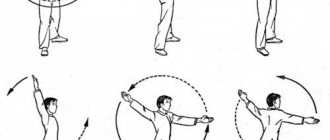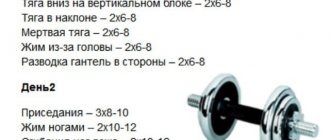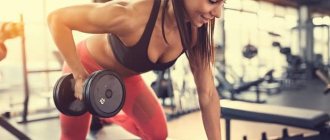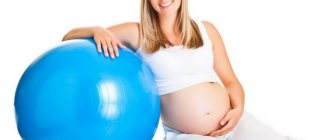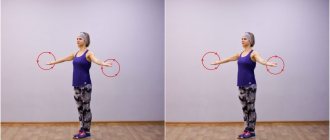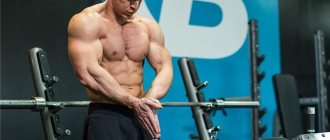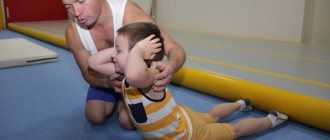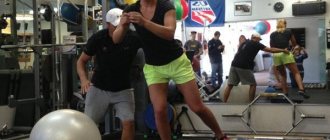Every athlete who practices rhythmic gymnastics knows perfectly well that correctly selected equipment for a given sport means half the success in competitions. As a rule, training for beginner athletes begins with an introduction to rhythmic gymnastics apparatus. The coach will tell you and explain how to choose the right equipment for training, established by the Gymnastics Federation.
In rhythmic gymnastics the following are used:
- jump rope;
- maces;
- ribbon;
- hoop;
- ball for rhythmic gymnastics.
Having learned how to choose the right ball for an athlete, you should turn your attention to the impeccably high-quality and inexpensive products of the Japanese brands sasaki and chacott, which have been successfully used by athletes all over the world for many years.
How to choose the right ball
In any sport, there are rules on how to choose this or that item yourself in order to achieve high results and conduct productive training.
Properly selected equipment means half the success in competitions.
So, when choosing a ball for rhythmic gymnastics, you should pay attention to the fact that this item must be made of high-quality rubber, an alloy of special rubber, or from materials that have the same strength as rubber.
At the same time, at the initial stage, rhythmic gymnastics allows the use of a ball made of plastic or less elastic rubber, which is very different from professional options in appearance and quality.
High-quality sasaki balls have long been loved by gymnasts because they have a special sticky coating and do not “run away” from their hands. At the same time, both small and large balls from this company are convenient to hold and perform various exercises with them.
The color of the ball does not play any role in training, but it does make the performance more colorful.
At the same time, balls of the Sasaki and Chacott brands may have exclusive shades and sparkles, but they are similar in quality to glossy equipment. An interesting coloring would be in the “chameleon” style, which can advantageously change its color depending on the degree and angle of illumination of the gym.
When selecting an object, you should pay attention to the physical characteristics of the athletes who will use it, since even the most ideal ball with a diameter of 15 cm will not suit a fifteen-year-old girl.
Types of fitballs
Based on the diameter, choose the correct projectile size as follows:
- An ordinary ball has a diameter of 45 to 95 centimeters; it can be used to perform exercises for all age groups; even the smallest one can withstand a weight of at least 150 kilograms.
- An oval gymnastic ball can withstand less weight, in the range of 100 - 150 kilograms, but it is more durable and is suitable for exercises that require stability.
- Massage fitballs can be large or quite small; they are softer and have small massage pimples that improve not only muscle tone, but also blood circulation.
- A gymnastic ball with horns - special handles - is intended for those who need to be stable for exercise - for example, children or pregnant women. You can safely jump on it or use it as a chair.
Choosing a ball according to the age and height of the athlete
It is very important to select the size of the ball, focusing on:
- age;
- height;
- palm size;
- the class in which the athlete competes.
The 15 cm rhythmic gymnastics ball is ideal for children under nine years of age, or for older girls whose height is shorter than their age. At the same time, for girls who have reached the age of ten, it would be better to purchase a high-quality ball, the size of which reaches 17 cm.
For those girls who celebrated their eleventh birthday, a ball with a diameter of 18.5 centimeters would be an ideal option. By the way, a ball of the same size for fifteen-year-old girls must be marked FIG Approved in order to be allowed to compete.
The 15 cm ball is ideal for babies under nine years of age.
It is worth clarifying that the athlete performs only in a strictly defined category, therefore the balls used in them differ in their weight:
- junior 13-15 centimeters – three hundred grams;
- junior 17 centimeters – three hundred and fifty grams;
- the standard for 18.5 centimeters is four hundred grams.
It is important to choose the right items according to the size of the athlete’s palm so that it is comfortable to hold.
How to care for the ball
It is recommended that for beginner athletes with a height of 120 centimeters, you should select a ball with a diameter of sixteen centimeters. They will be able to provide quality training for another couple of years without spending money on new equipment.
However, during this time, items for rhythmic gymnastics must be properly stored to prevent scratches and loss of appearance.
In order to keep the gymnastic ball in perfect condition, you need to remember the following rules:
- constantly pump up with a special, preferably branded, pump;
- in winter, use an insulated cover for transportation;
- if there is no insulated cover, you can transport the ball in a woolen hat;
- Protect from direct sunlight.
So, a gymnastic ball case of the correct size is selected for a specific time of year and is designed to:
- protect from scratches;
- from the negative influence of the sun's rays;
- do not damage the varnish coating;
- maintain volume/pressure at low temperature;
- protect from damage to the surface.
It is important to remember that even branded products have their own warranty period, which, for example, for Sasaki products was two months with a shelf life of one year.
Fitball for babies and expectant mothers
A Russian study noted that fitball gymnastics is contraindicated for children with hypertonicity, disorders of the auditory sensory system and delayed extinction of tonic reflexes.
To be sure there is no harm, before starting training, consult a pediatrician and, if necessary, a neurologist.
Fitball gymnastics will not hurt healthy children, especially if you start gradually and monitor the child’s condition.
Pediatricians recommend exercises on a fitball for harmonious physical development for most infants.
There are some medical indications for using the ball:
- hypertonicity of any muscles;
- retardation in physical development;
- dysplasia;
- muscular dystrophy;
- digestive disorders;
- severe colic;
- frequent whims, sleep disturbances.
Classes are contraindicated in the following cases:
- the child does not like it, during exercises he begins to be capricious and twist;
- the child has a fever, cough, runny nose;
- the umbilical wound does not heal well.
The main goal of gymnastics on a fitball at 1-2 months is to improve digestion and prevent colic.
A set of fitball exercises for infants in pictures
At this time, the following exercises are performed:
- The child is placed with his stomach on the ball. An adult needs to support the shoulders and head with one hand, and the legs and hips with the other. Perform 5-6 swings forward and back.
- The baby is turned over and held in a similar way, but he is already lying on his back. 5-6 swings are performed. At 2 months you can add movements in a circle, left and right.
- The child is placed on a bed or sofa so that his legs hang down from the knee. Gently holding it, mom rolls up the fitball. Instinctively, the child pushes the ball away. The exercise is repeated 5-6 times.
At this age, children know how to hold their head up, so the exercises can be made more complicated, and gymnastics can be added to strengthen the muscle frame.
- The child is placed on his stomach. You need to hold his buttocks with one hand, and clasp his ankles with the fingers of the other. You need to make sure that the baby wraps his hands around the ball. During exercises, the child is rocked back and forth. Number of executions – 10.
- The baby is placed on his back on a fitball. One hand fixes the chest and shoulders, the other the hips and legs. It is necessary to perform swinging movements, lightly pressing on the ball. 10-12 swings are performed. With each subsequent one, you need to speed up the pace.
- The child is placed on his side. He holds the arm and shoulders with one hand, and the legs with the other. Light springy movements are performed, 10 repetitions. The exercise is repeated on the other side, on the stomach and back.
- The child is placed on his stomach, holding his back. The baby's legs and arms should clasp the fitball. Slowly the ball is rotated back and forth to its maximum length. It is recommended to complete the gymnastics with this exercise.
At 4 months, the child holds his head well, controls his hands and begins to navigate in space. Fitball becomes a big toy for him. The baby tries to push it, pinch it, taste it. The following exercises are recommended during this time:
- The baby lies on his back on the floor. An adult should roll the ball to his feet and ask him to push it away. 15-20 repetitions are performed.
- The baby lies on his stomach on a fitball. An adult, holding him by the armpits, moves the child back and forth. At the end of the amplitude of movement, you need to linger for 5-6 seconds. This helps to arch and stretch the muscles around the spine. 5 movements are performed.
- The Fiball is located close to the wall or sofa. The child lies with his stomach on the ball, his feet touching the wall. While holding the baby, you need to roll him to a hard surface so that his legs bend at the knees, and then let him push off with his heels. During the exercise, the muscles of the calves, thighs and back are trained, and the body is prepared for walking. Number of approaches: 5-6 times.
- The child lies on his stomach on a fitball. You need to put a bright toy near the ball. Holding the baby by the legs, the adult tilts the fitball towards the toy until the child grabs it. It must be remembered that you cannot stay in this position for a long time. Repeated 3-4 times.
- The exercise is performed similarly to the previous one, but the toy is placed slightly to the side of the fitball. To get it, the child needs to turn his head to the side and reach with his hands. This perfectly trains the vestibular apparatus and spatial orientation.
At this age, many children try to sit and then walk. Their muscles and bones require more intense training to become well strengthened. At this time, fitball helps accelerate physical development and improve coordination in space.
- An adult sits on the floor and holds the fitball between his legs. The child must be seated or placed on the ball. Springy squats or jumps are performed. Children really like this exercise, so you can do it for 5 minutes with breaks of 10-15 seconds. Daily gymnastics with jumping on a ball perfectly trains the vestibular system.
- The exercise is performed with children who sit well and hold their back. The child is placed on a fitball. The adult holds the child by the waist with one hand, and the outstretched arms with the other. The baby's task is to maintain balance. The exercise is performed for 25-30 seconds. After a while, you can complicate it: hold the child only by the hands.
- The child is on the fitball with his stomach, his hands are clasping the ball. An adult raises the baby's legs at the level of his body and swings the ball back and forth, imitating working with a wheelbarrow. 10-15 movements are enough.
- The child lies on his back, his legs can be lightly supported by his hands. An adult pulls the child's arms from a lying position to a sitting position. It is recommended to say “get up” and “sit down.” The exercise is useful for children who do not yet sit independently. 5-6 approaches are performed.
- The child stands on his legs, the adult holds his waist with his hands. The fitball serves as a support, which rolls to the side when pressed. This encourages the baby to take steps. The exercise is performed for 4-5 minutes. It is only suitable for those children who can stand on a support. It is necessary to insure the baby by holding him by the waist even if the child is already walking independently.
Dysplasia is a joint deformity that, if left untreated, can cause inflammation and lameness in the future. The pathology can be successfully treated with special clothing, massage and gymnastics. For a positive effect, exercises must be done daily.
- The child is on his back. An adult fixes him by the stomach with one hand so that the pelvis is fixed, and with the other he alternately makes circular movements with the lower limbs. Number of approaches: 4-5.
- The child continues to lie on his back. An adult secures the baby with one hand, and with the other performs an exercise that imitates riding a bicycle. Can be performed on each leg separately 4-5 times.
- The baby is placed on his stomach and his hands clasp the fitball. An adult alternately bends his legs at the knee and hip joints, imitating the pose of a frog. The pose is fixed for 5-6 seconds, then the ball rolls back and the legs straighten. 8 approaches are performed.
- Position on the stomach. The technique is similar to the previous one. During its execution, the knees are separated as much as possible and the heels touch. The fitball moves back and forth, the folded heels are moved towards the buttocks for a few seconds, then the legs are straightened. 4-5 approaches are performed.
Muscular dystonia is a disease in which tone is reduced or increased. For treatment, massage, exercises in the pool and on a fitball are used.
- The child is placed on his stomach on a fitball. Legs should be bent at the knees and pressed against the ball. One of the parents holds the child by the hands, the other holds the legs. During the exercise, the child is rolled forward and backward. The number of movements is no more than 10.
- The child is on the ball with his stomach. The legs are supported by the hands of an adult. The fitball slowly leans forward until the child touches the floor with his hands. Then the exercise is performed in a similar way, but the hands are holding. Can be performed at 6 months of age and older. Number of approaches: 3-4 times.
- The child is placed with his back on the fitball. Supporting your stomach, you need to perform 5-6 springy movements with smooth rolls back and forth, left and right. The lesson is conducted for children 2-6 months old.
The famous children's doctor Komarovsky believes that fitball exercises are only useful if they are performed correctly.
The following tips must be followed:
- It is strictly forbidden to engage in any gymnastic exercises if the child does not feel well, has a runny nose or fever;
- It is better to postpone exercise on a fitball for babies if the baby is capricious or wants to sleep;
- You can’t put a child on a “naked” fitball: firstly, the rubber is cold and unpleasant to the body, and secondly, it can stick and injure the skin;
- you cannot use a fitball immediately after birth: the musculoskeletal frame of the baby will be ready for the first rocking exercises only 2-3 weeks after discharge from the hospital;
- accuracy is an important element of the exercises: the exercises should not be carried out very intensively, especially in the first months, strong pressing and swinging can lead to muscle injuries;
- You should not leave your baby’s head and neck unattended for up to 5 months; even if he holds his head well, lack of support can cause a dislocation of the neck.
Fitball exercises for mothers and babies can be combined. There are a number of exercises that not only improve the baby’s health, but also help the mother get in shape faster after childbirth.
